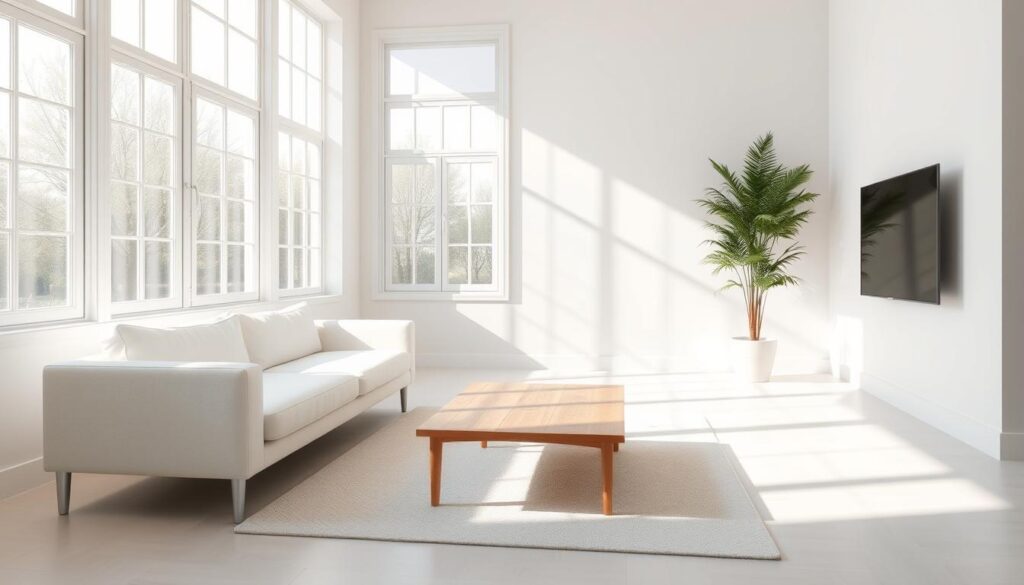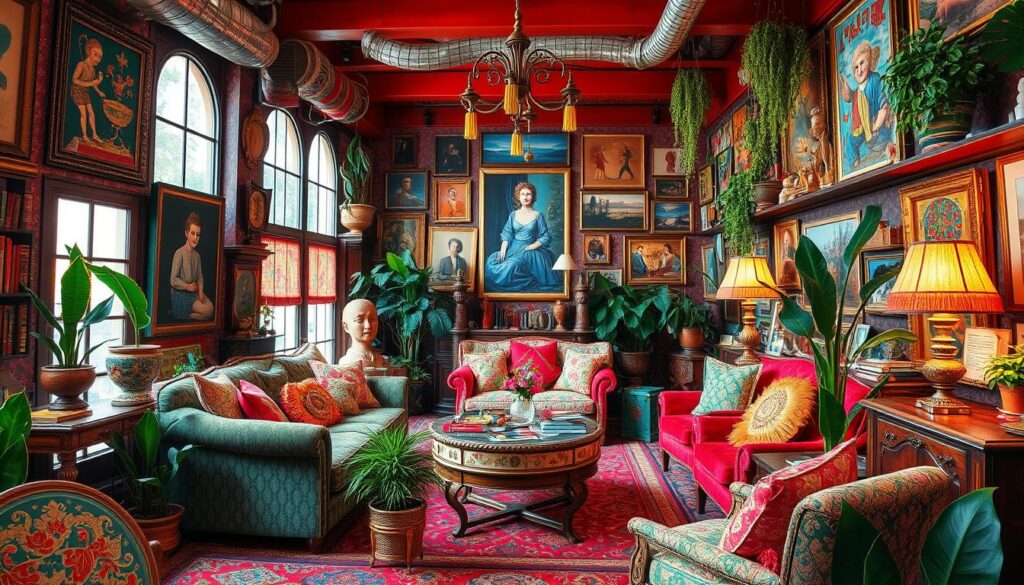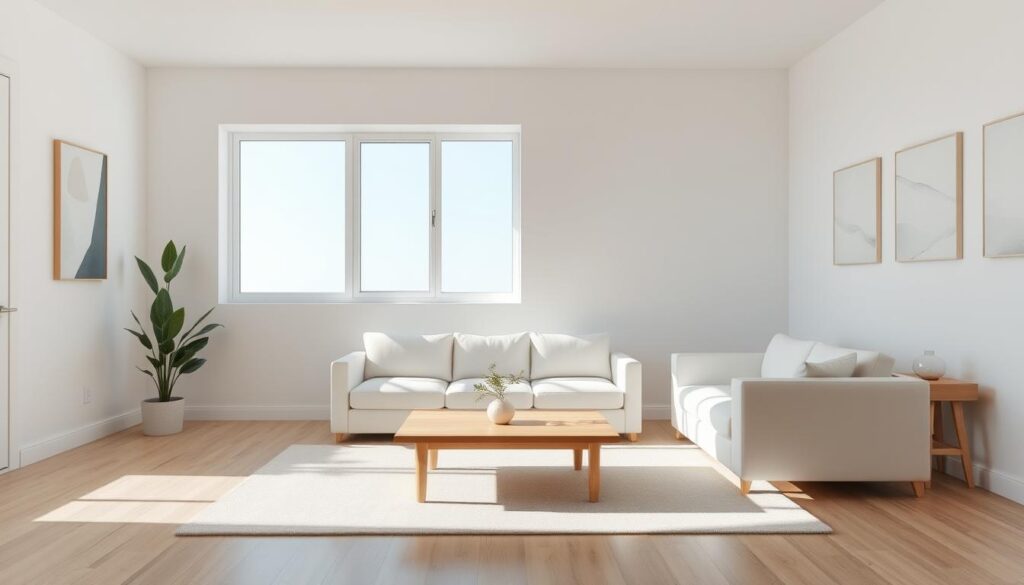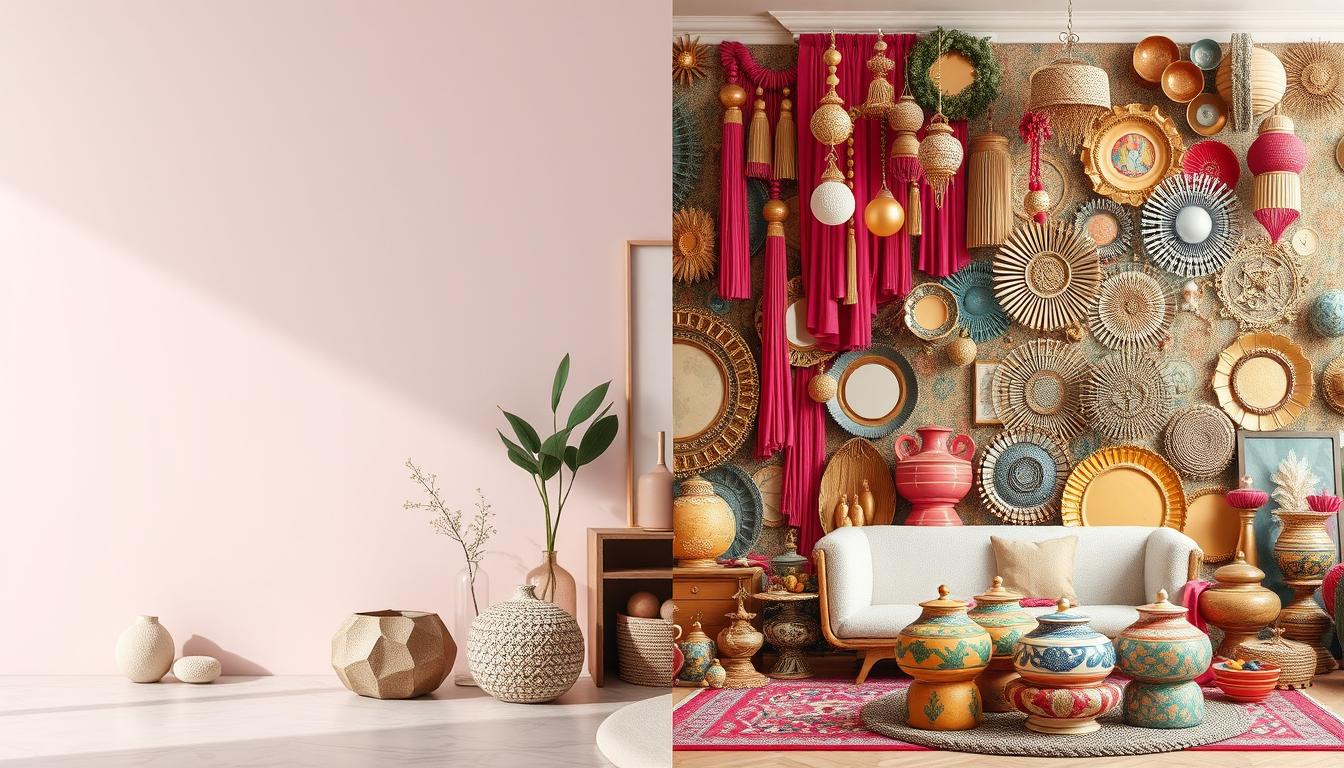When we look at interior design, we see two main styles: minimalism and maximalism. These styles let us show our personal taste and the mood we want in our homes.
Minimalism is all about simplicity and clean looks. It’s become very popular lately. On the other hand, maximalism is bold and full of layers. It’s for those who love to show their personality through their design.
We’ll dive into what minimalism and maximalism are all about. We’ll look at how they’ve changed over time and their impact on today’s homes. Knowing about these styles helps us choose the right one for our space and taste.
Understanding Minimalism, Maximalism, Design Aesthetic: A Modern Perspective
Interior design brings us face-to-face with Minimalism and Maximalism. These styles have changed over time, shaped by culture and society. Knowing about these aesthetics helps us appreciate our living spaces more.
The Evolution of Design Philosophy
Minimalism started in the 20th century as a response to old, cluttered designs. It focuses on simplicity, clean lines, and function. This lets space and light shine.
Maximalism, however, is all about bold colors, patterns, and layers. It’s a way to show off personal style and creativity.
Cultural Influences on Aesthetic Choices
Our design choices are shaped by culture and society. Minimalism became popular after World War II for its simplicity and function. Maximalism, on the other hand, lets people express themselves freely through their spaces.
Impact on Contemporary Living
The debate between Minimalism and Maximalism changes how we design our homes. Our choices show our values and personality. Exploring these styles helps us understand how our spaces affect our emotions.
The Core Principles of Minimalistic Design
Minimalism is all about simplicity, functionality, and the beauty of less. It’s about decluttering and focusing on what’s truly essential. This way, we make spaces that are calm and encourage us to live more intentionally.

The “less is more” idea is at the heart of minimalist design. We aim to remove things we don’t need. This means clean lines, simple colors, and furniture that does more than one thing. Such a design makes spaces look better and feel calmer.
Essentialism is a big part of minimalism. It’s about picking what’s most important in our lives. In design, this means choosing our belongings and spaces wisely. We only keep things that truly matter and bring us happiness.
Minimalistic design helps us live more clearly and intentionally. It makes our homes look better and helps us live simpler, more mindful lives.
Exploring Maximalist Expression in Interior Spaces
Maximalism is a bold style that celebrates individuality. It’s a counterpoint to minimalist design. In maximalist interiors, we see vibrant ornate decor, eclectic style, and bold design. These elements create striking, personalized environments.
Color Psychology in Maximalist Design
Maximalist design uses vivid, saturated colors to evoke emotions. It combines unexpected color pairings and layers hues. This creates interiors that reflect our unique personalities.
The psychology of color is key in maximalist design. It allows us to create moods and evoke feelings in the space.
Pattern Mixing and Layering Techniques
Maximalism loves pattern mixing and layering. It uses diverse patterns and textures to create a stimulating environment. By balancing these elements, we achieve depth and visual interest.
This approach creates a truly eclectic style that makes our spaces stand out.
Statement Pieces and Bold Accents
Maximalist design focuses on bold, attention-grabbing statement pieces and accents. These elements, like an ornate chandelier or a vibrant area rug, become the room’s centerpiece. They are the heart of the design.
By incorporating these bold features, we create maximalist interiors that showcase our individuality.

How to Incorporate Minimalist Elements in Your Space
Embracing Minimalism can turn your living spaces into peaceful retreats. The goal is to focus on Simplicity and choose only what’s essential. Begin by clearing out anything you don’t need. This makes your space look clean and lets important items stand out.

Choose furniture and decor that lasts and does more than one thing. A Capsule Wardrobe approach works well at home too. Pick items that are versatile and of high quality. Stick to a neutral color scheme and use natural materials like wood and stone. This creates a calm and unified look.
Minimalism isn’t about cutting out everything you love. It’s about choosing wisely what truly adds value to your life. By doing this, you create a space that looks great and feels good.
Maximalist Styling: Tips for Balanced Excess
Maximalist design is becoming more popular in interior design. It offers a bold way to show your personal style. We’ll look at how to make a space look good, even with lots of Maximalism, Bold Design, and Ornate Decor.
Creating Visual Interest Through Collections
Maximalist design loves collections. It could be vintage cameras, different pottery, or art. Placing these items thoughtfully makes a space interesting and deep.
Texture and Material Combinations
Maximalist design plays with textures and materials. Mixing smooth and rough, or natural and fancy materials adds depth. Try different textures and materials to make your space interesting and balanced.
Art and Decor Placement
Where you put art and decor is key in maximalist styling. It’s about using bold pieces that grab your attention. Layer artwork, place sculptures in corners, and make vignettes. The goal is to balance lots of items with a cohesive look.
Maximalist styling can make your space both eye-catching and personal. It’s about finding the right balance between boldness and harmony.
The Psychology Behind Design Choices
Our love for Minimalism or Maximalism in interior design is more than just about looks. It’s influenced by our personal experiences, culture, and personality. These factors make our design choices complex and deeply personal.
Minimalism’s clean lines and simplicity appeal to those who want calm and control. It shows a need for focus and mental clarity. On the other hand, Maximalism’s bold colors and patterns speak to those who love self-expression and creativity.
Our cultural background also plays a big role in our design choices. Different cultures have their own design values. Knowing these can help us understand why we prefer certain styles.
Our design choices greatly affect our well-being and mood. By choosing designs that match our needs, we create spaces that uplift us. These spaces not only look good but also improve our happiness and productivity.
Finding Balance: When to Mix Both Styles
In the world of interior design, Minimalism and Maximalism are big topics. But, the secret to amazing spaces is mixing these styles. This way, we get a eclectic style that shows off our taste and lifestyle.
Transitional Spaces and Hybrid Designs
Transitional spaces mix minimalist and maximalist styles. This creates a smooth and beautiful look. By adding bold colors and patterns, we make a hybrid design that flows well.
Room-by-Room Adaptation Strategies
Using a room-by-room strategy helps mix styles. This way, each space gets the right feel. For example, a minimalist office works well, but a maximalist living room is perfect for cozy vibes.
Finding the right mix is all about what we like and the space’s features. By blending minimalist and maximalist styles, we create a unique eclectic style. This style makes our homes truly special and enjoyable.
Common Mistakes to Avoid in Both Aesthetics
Designers need to be careful with minimalism and maximalism. One big mistake is not understanding the basics of each design aesthetic. Minimalists might make spaces too cold, while maximalists can make them too cluttered.
Another error is not achieving balance. Minimalist spaces can feel flat without texture or personal touches. Maximalist rooms can be too much if they lack calm areas. It’s key to find a balance between simplicity and richness.
Many designers see minimalism and maximalism as fixed, not flexible. But, these styles can be mixed and matched to create unique spaces. By seeing these styles as adaptable, homeowners can explore endless creative options.
Conclusion
The choice between minimalism and maximalism is very personal. It depends on what we like, how we live, and our culture. Minimalism gives us a calm, clean space. Maximalism lets us show our bright personalities and enjoy life more.
Design is about making spaces that fit our needs and dreams. We suggest trying both minimalism and maximalism. Find the mix that best shows your design aesthetic and intentional living. This way, you can make a space that feeds your soul and shows who you are.
Keep exploring in your design journey. There’s no one right way to find happiness. Be brave, curious, and listen to your gut. It will lead you to a space that truly reflects you. The adventure itself is the greatest reward.



